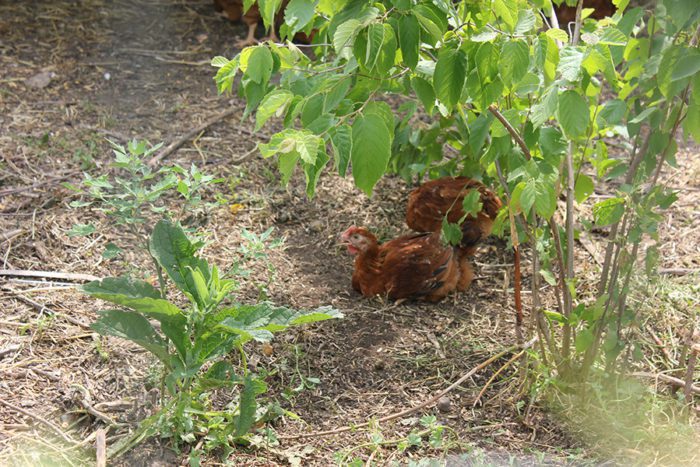Matt Leavitt
Albert Lea Seed, Organic Agronomist
In June 2021, Albert Lea Seed agronomist Matt Leavitt and marketing coordinator Ashley Bingham toured Regi Haslett-Marroquin’s 22-acre Tree-Range farm and 75-acre training and demonstration site in Northfield, Minnesota. The demonstration site has been planted with 10,000 hazelnut trees, Albert Lea Seed’s Organic Pasture Mix, and a barley nurse crop in preparation for paddock and chicken coop installation. They also toured Wil Crombie’s Tree-Range paddock system near Faribault, which has been operating the regenerative poultry program for four years.
“You have to indigenize your thinking,” explains Regi Haslett-Marroquin, Tree-Range chicken farmer and founding board president of The Regenerative Agriculture Alliance, as we toured his farm near Northfield, Minnesota. “The current model of agriculture is extraction-driven, which sacrifices the health of the land, ecology of the earth, and the people—in favor of profits. A lot of what I see people experimenting with as regenerative agriculture is a way of thinking applied from the collective agricultural wisdom of indigenous cultures—such as building soil, protecting water, and creating equitable local food economies.”
Regi has worked to honor and build upon the collective wisdom of indigenous cultures—from his native landscape in Western Guatemala to Minnesota—since the mid-1980s. He’s combined his own overflowing passion, tireless work ethic, and systems thinking into endeavors like Peace Coffee (an organic, shade-grown, fair-trade coffee cooperative based in Minneapolis) and a pastured, multifunctional poultry system known as Tree-Range.
Tree-Range System
Tree-Range farm chickens are kept in 1.5-acre rotationally grazed, fenced paddocks that include pasture alleyways interspersed with rows of agroforestry trees like elderberry and hazelnuts. The trees not only provide shade, habitat, and protection from predators, but they also provide additional income streams and numerous soil-building benefits. In addition to grazing and feed, chickens are also given sprouted grains from the pasture alleys, which minimizes the cost of grinding and feed processing and allows for greater nutrient uptake.
“The farm system doesn’t stop at the driveway,” says Regi. “Every aspect of the farm, including purchased inputs, support or processing services from off-farm, as well as every social, physical and biological interaction has to be considered. The processing infrastructure, feed supply, and end-markets are all part of the system and need to be working in concert to support the regenerative goals.”
And it’s not just economically viable but also scalable. There are currently 10 new farms across southern Minnesota (with 20 more in training) that are part of the Tree-Range marketing co-op. They are actively engaging all supply chain stakeholders to create markets both for the chicken but also the hazelnuts, elderberries, and other crops that are a part of this system so success is widespread and shared across all members.
Regenerative agriculture to Regi and other Tree-Range farmers is a whole farm approach—encompassing all facets of production, processing, and marketing. The grain supply chain, processing infrastructure, land access, capital, farm infrastructure, and marketing apparatus are all part of the regenerative ecosystem.
Regenerative Ag Venture Coming to Albert Lea
We’re excited to announce that the Regenerative Agriculture Alliance has established a partnership with the Minnesota state legislature to launch a regionally branded regenerative agriculture development park out of Albert Lea. This park will serve as a processing and sourcing hub for the poultry program to scale up and feed 10 million broiler chickens and 500 million eggs. Along with that will be the capacity to aggregate and process value-added agricultural products from both poultry and tree products like hazelnuts and elderberries. Other services like farm lending, banking, technical assistance, and business development would also be housed in this park, leading to a full suite of support infrastructure for long-term farm viability. This proposed park is in addition to the cooperatively-owned poultry processing plant in Stacyville, Iowa that the cooperative purchased last year. They are currently working to execute strategy and plan the first stages of growth and development.
Regenerative agriculture is a hot buzzword in the agricultural community right now and many farmers, consumers, food companies, and agricultural processors are attempting to define and understand what exactly that term means. Few have given the amount of on-the-ground practical trialing and wholesale systems-level analysis that Regi has brought from his years of experience. As he said, “We are extremely practical, business-oriented, outcomes-centered, and especially seek to build ecosystem-level infrastructure so we can shift governance, ownership, and control of regenerative agriculture to communities in a collective manner.”
We look forward to seeing this project roll out in Albert Lea and southern Minnesota and feel that this could have numerous benefits to the local farming community. We welcome the opportunity to be a willing partner in growing a tangible regenerative agricultural market in our own backyard.
—
Read more about the Regenerative Agricultural Alliance and the Tree-Range brand at www.regenagalliance.org and www.regenerationfarms.com.




